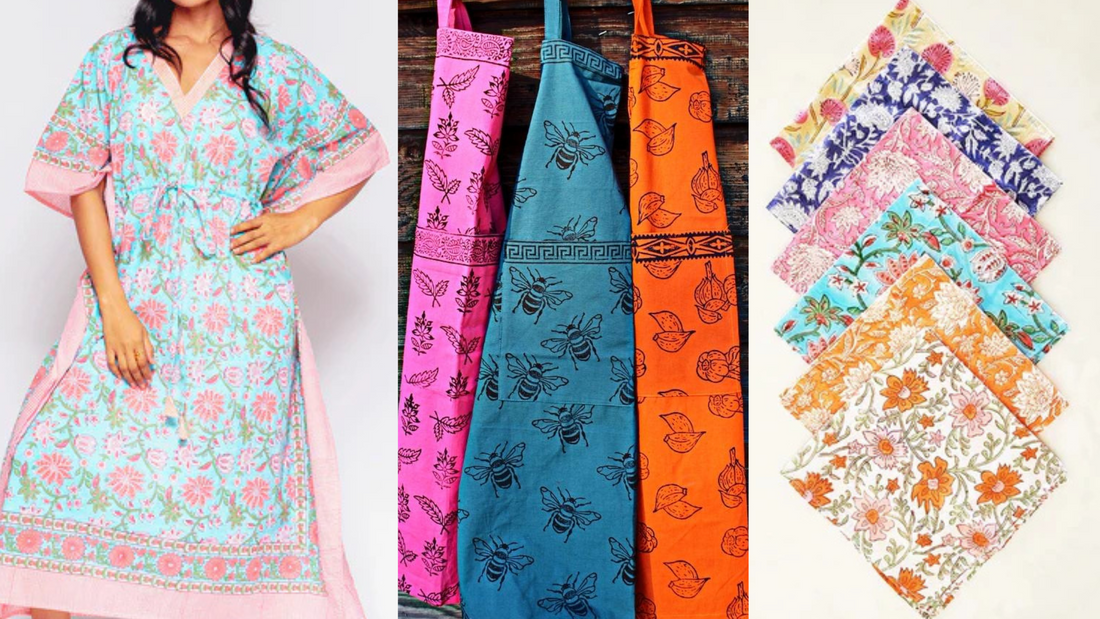
The History, Heart, and Art of Block Printing
Block printing is one of the world's oldest textile art forms. In this post, we're diving into how this intricate, handmade process works and why it still matters today. Did you miss the series intro? Check it out here! Ready to be immersed in the world of block printing? Let’s go!

A Mini History
Block printing is a centuries-old technique. According to the Asian Art Museum, “Scholars believe that woodblock printing first appeared in China around 600 [CE], probably inspired by the much older use of bronze or stone seals to make impressions on clay and silk.” While block printing has a deep history, its beauty lies in the process.
Creating A Hand Block Print
The process of hand block printing varies by style and geography, but no matter where you are, it is an intricate, multi-step process.
The first step involves hand-carving a block of wood. The type of wood being carved varies by region. Popularly used in India are Teak, Sycamore, and Pear wood.
The more detailed the pattern, the more blocks it takes. Some designs require hundreds of individually hand-carved blocks to complete.
The carved wood block is then dipped in paint and stamped or pounded, typically with a hand or hammer, repeatedly onto the fabric to create the pattern. For more intricate designs, the separate colors and shapes cannot be applied until the previous layer of print is dried.
A Sustainable Practice
Fair trade groups emphasize sustainability by using organic fabrics, natural dyes, and traditional washing and drying methods, keeping the entire process handmade and low-impact.
At Latitudes, we partner with many groups that use sustainable hand block printing practices. Sevya produces clothing like this Caftan block printed in India on 100% cotton. Passion Lilie has a focus on organic dyes like their breathable floral top. Artisans in Nepal work with Ganesh Himal to make clothing and bags. Artisans across South Asia block print aprons and tea towels with Mended.
Block printing is beautiful and rooted in tradition, but what does it mean for you?
The Benefits of Block Printing
If those reasons aren't enough, the list goes on. Especially as innovations continue, block printing is a sustainable option for adding prints to fabrics and clothing. Like many handmade items, the process is low-impact.
It doesn’t require electricity to hand-carve blocks or stamp the designs onto the fabrics. Next to sustainable practices, many of the materials used are also natural or recycled. Natural materials, like cotton, are often more breathable and gentle on your skin.
As we spend most of our time in clothes, it’s worth knowing what is sitting against our skin all day. Aside from comfort and health, handmade products are known for their higher quality.
Our block-printed garments are made to stand the test of time. Unlike synthetic, mass-produced clothing, block-printed pieces are made to last, both in quality and style.
The price you pay for a handcrafted, block-printed top may be a little more, but its quality will be better and its lifetime much longer.
A Better Life is Block Printed
Fair trade, block printed items support a better experience for you and the people who make them. You support the continued tradition and art of handmade textiles, provide yourself with higher-quality fabrics, and bring dignified work to artisans.

Do you already own anything that has been hand block printed? Your choice to support hand block printing helps keep this global art form alive and empowers the artisans behind it.
Thanks for reading, and we’ll see you next week to talk about the art of Ikat!
Until next time,
The Latitudes Team
P.S. - Like learning about global textile traditions? Sign up for our newsletter to be the first to read each post, get artisan stories, and explore new arrivals inspired by handmade techniques.


